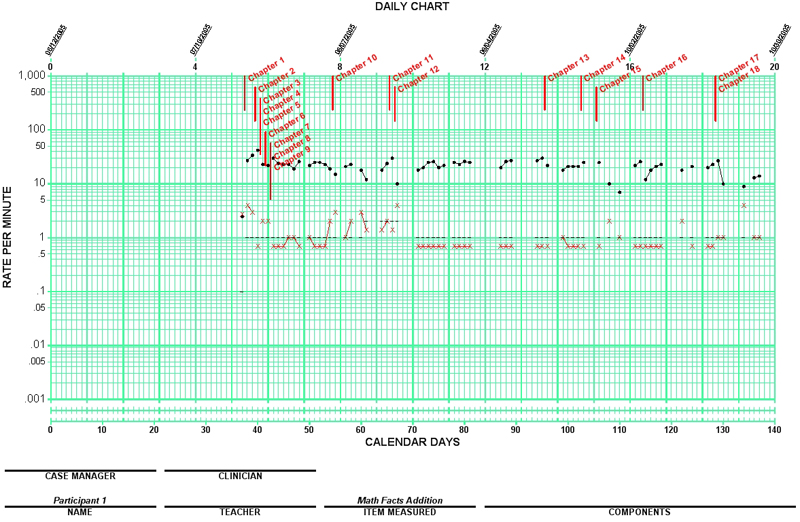
|
Use of Skin-Shock at the Judge Rotenberg Educational Center (JRC) |
THE VALUE OF BUILDING FLUENCY ON
INDIVIDUALLY-DETERMINED ERROR SETS
IN THE TEACHING OF BASIC MATH FACTS
Angela Galvin, Michelle I. Harrington, Edward Langford, and Matthew L. Israel, Ph.D.
Judge Rotenberg Educational Center
Canton, MA USA
The Judge Rotenberg Educational Center (www.judgerc.org)
operates day and residential programs for children and adults with behavior
problems, including conduct disorders, emotional problems, brain injury or
psychosis, autism, and developmental disabilities. The fundamental approach
taken at JRC is the use of behavioral psychology and its various technological
applications, including behavioral education, programmed instruction, precision
teaching, behavior modification, behavior therapy, behavioral counseling,
self-management of behavior, and chart-sharing.
At the Judge Rotenberg Center the implementation of a large portion of the basic
math curriculum is based on the principles of Precision Teaching. This includes
conducting multiple assessment timings with participants on basic facts until
they reach a high rate-per-minute correct and a low rate-per-minute incorrect
within each of the curriculum steps.
Subjects worked through a curriculum of basic math facts that was presented on a
computer using the see/type learning channel. The curriculum was modeled after
the principles of Precision Teaching. Materials were presented in small
increments. Each lesson was presented until a high rate of fluency was achieved
and data were plotted on the Standard Celeration Chart (Lindsley, 1992a,).
Subjects went through the addition and subtraction curriculum, or the addition
and multiplication curriculum, with and without building fluency on
individually-determined sets of errors that the student has made in the previous
chapter. This option was automatically activated if the student answered any
problem(s) incorrectly. The software presented the incorrect problem(s) and
prompted the student to complete as many 20 second timings as necessary until
the student made no errors. We examined how this option affected retention and
if it had an effect on the amount of time it took a student to master the
curriculum.
Methods
Participants and Setting
Participants in this study included 2 males, both of whom were enrolled at JRC
as full-time students in the residential program. Participant 1 was aged 16
years, 3 months with a Full Sale IQ of 42. His previous diagnoses included
impulse control disorder NOS, personality disorder, Hirschprung’s Disease, MR
and conduct disorder. When tested in July of 2005 with the Woodcock Johnson III
Test of Achievement, his Math Fluency was a 1.7GE. This placed him far below his
same-aged peers whose average grade equivalence would be a 10.0GE. Participant 2
aged was 19 years, 11 months with a Full Scale IQ of 66. His previous diagnoses
included cognitive DO/NOS (reported h/o), MR, Cannabis Abuse, r/o Dysthymic D/O,
deficits in speech and language and sequential thinking and perceptual
organizational skills. When tested in August of 2005 with the Woodcock Johnson
III Test of Achievement, his Math Fluency was a 2.3GE. This placed him far below
his same-aged peers whose average grade equivalence would be a 12GE.
These participants were chosen because they tested far below grade level in the
area of math fluency. The participants were in the same classroom during the
academic day, which was from 9AM to 3PM, Monday through Friday. Each participant
used a computer that was individually configured to meet both their behavioral
and academic needs. Both participants lived in JRC group homes and attended
school at JRC’s main school building.
Measures and Instruction
The participants worked through a curriculum of basic math facts that was
presented on a computer using the see/type learning channel. Both participants
completed at least 5 timings per day. The curriculum, which was presented in
small increments, was modeled after the principles of Precision Teaching. All
lessons were worked on until a high rate of fluency was achieved and data was
plotted on the Standard Celeration Chart (Lindsley, 1992a). The participants
were presented with a math problem and typed the answer. The participants were
required to answer problems at a pre-determined rate correct to move from one
lesson to the next. Participants received immediate feedback for correct and
incorrect responses.
Participant 1 went through the addition and subtraction curriculum. Participant
2 went through the addition and multiplication curriculum. Both participants
went through the addition lessons without building fluency on
individually-determined sets of errors that the student has made in the previous
chapter. Participant 1 went through the subtraction lessons by building fluency
on individually-determined sets of errors that he had made in the previous
chapter. Participant 2 went through the multiplication lessons by building
fluency on individually-determined sets of errors that he had made in the
previous chapter. This option was automatically activated if the student got any
problem(s) incorrect. The software presented the incorrect problem(s) and
prompted the student to complete as many 20 second timings as necessary until
the student made no errors.
Results
Participant 1 completed 1101 timings in fourteen addition lessons and 386 timings in fourteen subtraction lessons. Participant 1 had higher celeration rates in the lessons which required him to build fluency in individually-determined sets of errors; 10 of the 14 lessons had higher celeration. Celerations were determined using the successive timings chart. When tested in May of 2006 with the Woodcock Johnson III Test of Achievement, his Math Fluency increased to 2.9GE from 1.7GE. Participant 2 completed 445 timings in twelve addition lessons and 119 timings in twelve multiplication lessons. Participant 2 had higher celeration rates in the lessons which required him to build fluency in individually-determined sets of errors; 7 of the 12 lessons had higher celeration. Celerations were determined using the successive timings chart. When tested in May of 2006 with the Woodcock Johnson III Test of Achievement, his Math Fluency increased to 2.9GE from 2.3GE.
Participant 1
|
Addition (without building fluency in individually-determined sets of errors) |
Subtraction (with building fluency in individually-determined sets of errors)
|
||||
|
Lesson |
Celeration |
Trials to Criterion |
Lesson |
Celeration |
Trials to Criterion |
|
1 |
X1.44 |
72 |
1 |
X1.87 |
9 |
|
2 |
/1.04 |
16 |
2 |
X1.38 |
10 |
|
3 |
/1.02 |
3 |
3 |
X1.08 |
3 |
|
4 |
/1.07 |
4 |
4 |
/1.24 |
10 |
|
5 |
X1.00 |
16 |
5 |
X1.41 |
9 |
|
6 |
X1.00 |
48 |
6 |
X2.39 |
12 |
|
7 |
1 timing |
1 |
7 |
X1.52 |
37 |
|
8 |
X5.07 |
3 |
8 |
X2.61 |
18 |
|
9 |
X1.02 |
254 |
9 |
X1.15 |
59 |
|
10 |
/1.09 |
247 |
10 |
/1.41 |
12 |
|
11 |
X2.38 |
8 |
11 |
X1.15 |
69 |
|
12 |
X1.07 |
277 |
12 |
X1.57 |
21 |
|
13 |
X1.10 |
125 |
13 |
X1.25 |
65 |
|
14 |
X1.00 |
27 |
14 |
X52.56 |
52 |
|
Median Celeration X1.0 |
Median Celeration X1.395 |
||||
Daily, Best per day, Addition chart

Daily, Best per day, Subtraction
chart
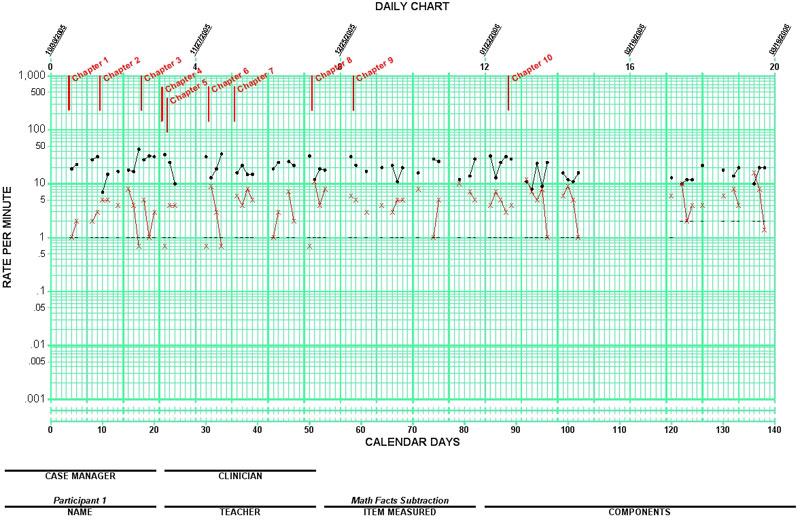
Daily, Best per day, Subtraction
chart (cont)
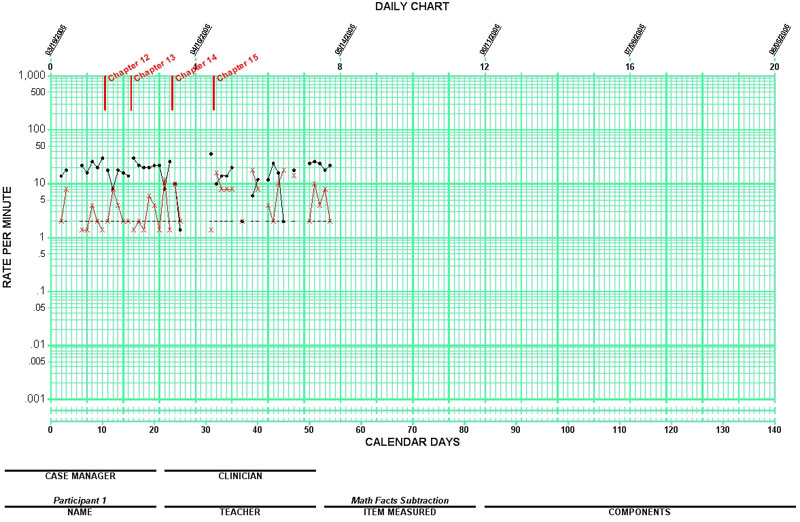
Participant 2
|
Addition (without building fluency in individually-determined sets of errors) |
Multiplication (with building fluency in individually-determined sets of errors) |
||||
|
Lesson |
Celeration |
Trials to Criterion |
Lesson |
Celeration |
Trials to Criterion |
|
1 |
X12.31 |
2 |
1 |
X1.10 |
7 |
|
2 |
X2.16 |
11 |
2 |
/2.05 |
14 |
|
3 |
/1.40 |
14 |
3 |
X1.94 |
2 |
|
4 |
X1.22 |
16 |
4 |
X5.36 |
3 |
|
5 |
X1.02 |
42 |
5 |
X1.27 |
3 |
|
6 |
/1.29 |
9 |
6 |
X1.39 |
7 |
|
7 |
X1.12 |
10 |
7 |
X1.27 |
5 |
|
8 |
X1.28 |
24 |
8 |
X1.22 |
4 |
|
9 |
X1.43 |
120 |
9 |
X1.35 |
8 |
|
10 |
X1.16 |
60 |
10 |
X1.25 |
18 |
|
11 |
X1.08 |
111 |
11 |
X1.02 |
11 |
|
12 |
X1.48 |
26 |
12 |
X3.86 |
37 |
|
Median Celeration X1.19 |
Median Celeration X1.27 |
||||
Daily, Best per day, Addition chart

Daily, Best per day, Addition chart (cont)
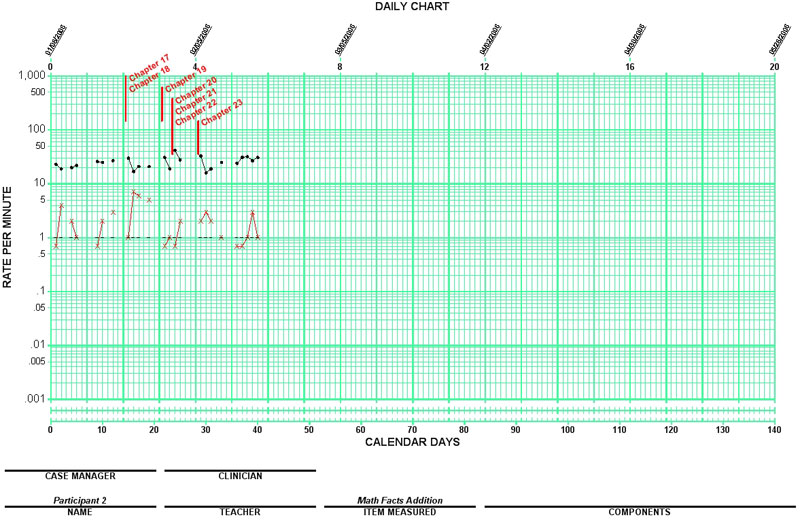
Daily, Best per day, Multiplication chart
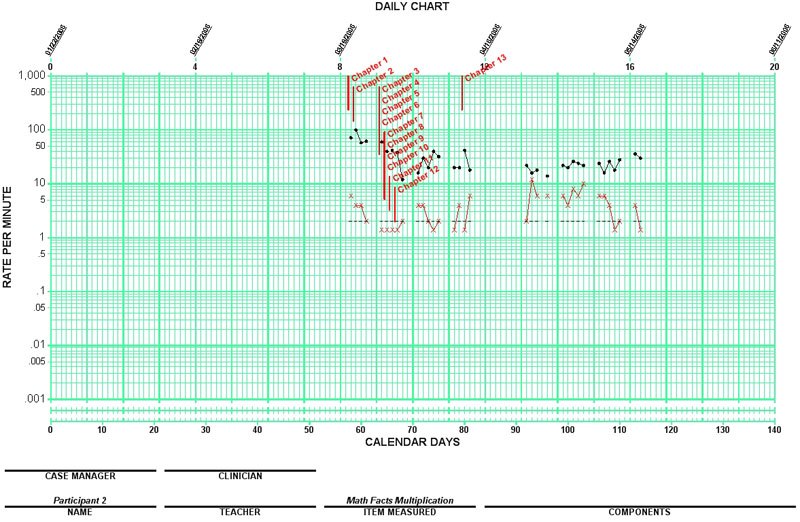
Discussion
There was a difference in the participants’ progress in lessons with and without building fluency on individually-determined sets of errors. The participants completed fewer timings and had a higher celeration by building fluency on individually-determined sets of errors as well as increasing their math fluency. Further study can examine the effects of building fluency on individually-determined sets of errors on other math operations or other academic areas that are too difficult for the student.
References
Lindsley, O. R. (1992a). Precision teaching: Discoveries and effects. Journal
of Applied Behavior Analysis, 25, 51-57.
McDermott, P., & Watkins, M. (1983). Computerized vs. conventional remedial
instruction for learning disabled pupils. The Journal of Special Education,
17(1), 81-88.
Chiang, B. (1986). Initial learning and transfer effects of microcomputer drills on LD Participants' multiplication skills. Learning Disability Quarterly, 9(2), 118-123.